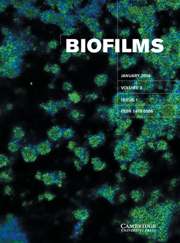Carbon substrate utilization as a method of studying biofilm development
Published online by Cambridge University Press: 02 June 2006
Abstract
The aim of this work was to study the community level physiological profile of a developing oral biofilm. Mixed-species biofilms, derived from human saliva, were grown in a constant-depth film fermentor for up to 240 h. Biolog GP2 microplates were inoculated with saliva or homogenized biofilms and incubated at 37 °C. The results showed that a biofilm community could utilize a range of substrates more diverse than those of their planktonic counterparts. Following the construction of dendrograms, a temporal relationship was demonstrated between the inoculum and biofilms, and the difference in communities over time was also resolved by using an eight-digit code of positive carbon sources. The diversity of the populations could be determined through the use of the community level physiological profile and the treatment of the data may augment the interpretation of the results. Methods such as community level physiological profiling may provide a valuable insight into the composition of biofilm communities associated with oral health and disease.
- Type
- Research Articles
- Information
- Copyright
- 2006 Cambridge University Press
- 4
- Cited by


